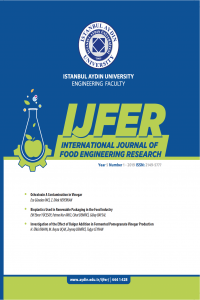Bacillus spp. Responsible for Spoilage of Dairy Products
Bacillus spp. Responsible for Spoilage of Dairy Products
Milk, , Dairy Products, Bacillus spp., , Spoilage in Dairy Products,
___
- [1] A.K., Chopra and D.K., Mathur, 1984. “Isolation, screening and characterization of thermophilic Bacillus species isolated from dairy products,” Journal of Applied Bacteriology vol.57, pp. 263-271
- [2] A., Ternstrom, A.M., Lindberg, G., Molin, 1993. “Classification of the spoilage flora of raw and pasteurized bovine-milk, with special reference to Pseudomonas and Bacillus,” J. Appl. Bacteriol., vol. 75, pp. 25-34
- [3] A., Rueckert, R.S., Ronimus, H.W., Morgan, 2004. “A RAPD based survey of thermophilic bacilli in milk powders from different countries,” International Journal of Food Microbiology vol. 96, pp. 263-272
- [4] B., Petterson, F. Lembke, P. Hammer, E. Stackebrandt, and F. G. Priest, 1996. “Bacillus sporothermodurans, a new species producing highly heat-resistant endospores,” Int. J. Syst. Bacteriol., vol. 46, pp. 759-764
- [5] C., Aouadhi, A., Maaroufi and S., Mejri. 2014. “Incidence and characterization of aerobic sporeforming bacteria originating from dairy milk in Tunisia,” Int. J. Dairy Technol., vol. 67, pp. 95-102
- [6] C.P., Champagne, R.R., Laing, D., Roy, A.A., Mafu, M.W., Griffiths, 1994. “Psychrotrophs in dairy-products - their effects and their control,” Crit. Rev. Food Sci., vol. 34, pp. 1-3
- [7] D., Xu, J., Côté, 2003. “Phylogenetic relationships between Bacillus species and related genera inferred from comparison of 3′ end 16S rDNA and 5′ end 16S–23S ITS nucleotide sequences,” Int. J. Syst. Evol. Microbiol., vol. 53(3), pp. 695-704
- [8] E.M., Mıkolajcık, N.T., Simon, 1978. “Heat Resistant Psychrotrophic Bacteria in Raw Milk and Their Growth at 7 ºC,” Journal of Food Protection, vol. 41 No.2, pp. 93-95
- [9] E.M., Crielly, N.A., Logan, A., Anderton, 1994. “Studies on the Bacillus flora of milk and milk products,”Journal of Applied Bacteriology, vol. 77, pp. 256-263
- [10] G., Kumarsan, R., Annalvilli, K., Sivakumar, 2007. “Psychrotrophic spoilage of raw milk at different temperatures of storage,” Journal of Applied Science Research, vol. 3, pp. 1383-1387 Ledenbach, H. and R.T. Marshall. 2009. Microbiological Spoilage of Dairy Products. W.H. Sperber, M.P. Doyle (eds.), Compendium of the Microbiological Spoilage 41 of Foods and Beverages, Food Microbiology and Food Safety, DOI 10.1007/978-1-4419-0826-1_2, C Springer Science+Business Media, LLC 2009
- [11] G., Lücking, M., Stoeckel, Z., Atamer, J., Hinrichs, M., Ehling-Schulzc, 2013. “Characterization of aerobic spore-forming bacteria associated with industrial dairy processing environments and product spoilage,” International Journal of Food Microbiology, vol. 166 Issue 2, pp. 270-279
- [12] J.H. Hanlin, 1998. “Spoilage of acidic products by Bacillus species,” Dairy foods and environmental sanititation, vol.18, pp. 655-659
- [13] L., Chen, T., Coolbear, R.M., Daniel, 2004. “Characteristics of proteinases and lipases produced by seven Bacillus sp. isolated from milk powder production lines,” International Dairy Journal, vol.14, pp.495–504
- [14] M.W., Griffiths, 1990. “Toxin production by psychrotrophic Bacillus spp. present in milk,” Journal of Food Protection, vol. 53, pp. 790-792
- [15] M., Magnusson, A., Christiansson, B., Svensson, 2007. “Bacillus cereus spores during housing of dairy cows: factors affecting contamination of raw milk,” J. Dairy Sci., vol. 90, pp. 2745-2754
- [16] M.O., Iurlina, A.I., Saiz, S.R., Fuselli, R., Fritz, 2006. “Prevalence of Bacillus spp. in different food products collected in Argentina,” LWT, vol. 39, pp. 105-110
- [17] M.E., Kable, Y., Srisengfa, M., Laird, J., Zaragoza, J., McLeod, J., Heidenreich, M.L., Marco, 2016. “ The core and seasonal microbiota of raw bovine milk in tanker trucks and the impact of transfer to a milk processing facility,” mBio, vol. 7 (4):e00836
- [18] R.R., Meer, J., Baker, F.W., Bodyfelt, M.W., Griffiths, 1991. “Psychrotrophic Bacillus spp. in fluid milk products: a review,” Journal of Food Protection vol. 54, pp. 969-979
- [19] R., Rombaut, K., Dewettinck, G., de Mangelaere and A. Huyghebaert, 2002. “Inactivation of heat-resistant spores in bovine milk and lactulose formation,” Milchwissenschaft, vol. 57, pp. 432-436
- [20] R.S., Ronimus, L.E., Parker, N., Turner, S., Poudel, A., Ruckert, H.W., Morgan H W, 2003. “A RAPD-based comparison of thermophilic bacilli from milk powders,” International Journal of Food Microbiology, vol.85, pp. 45–61
- [21] S., Cosentino, A.F., Mulargia, B., Pisano, P., Tuveri, F., Palmas, 1997. “Incidence and biochemical characteristics of Bacillus flora in Sardinian dairy products,” International Journal of Food Microbiology, vol. 38, pp. 235-238
- [22] S., Kalkan, K., Halkman, 2006. “Bacillus cereus ve İçme Sütünde Oluşturduğu Sorunlar,” Orlab On-Line Microbiology Journal, vol. 04/1, pp. 1-11
- [23] S., Kmiha, C., Aouadhi, A. Klibi, A., Jouini, A. Béjaoui, S., Mejri, and A., Maaroufi, 2016. “Seasonal and regional occurrence of heat-resistant spore-forming bacteria in the course of ultra-high temperature milk production in Tunisia,” J. Dairy Sci., vol. 100, pp. 1-10
- ISSN: 2149-5777
- Başlangıç: 2015
- Yayıncı: İstanbul Aydın Üniversitesi
Bacillus spp. Responsible for Spoilage of Dairy Products
Burcu MARANGOZ, Sibel KAHRAMAN, Kamil BOSTAN
An Investigaton on the Deterioration of Packaged Chicken Doner
Hydroxymethylfurfural (Hmf) Formation in Milk and Dairy Products
Harun R. ÖZDAL, Bihter YILDIZ, Güner ARKUN
